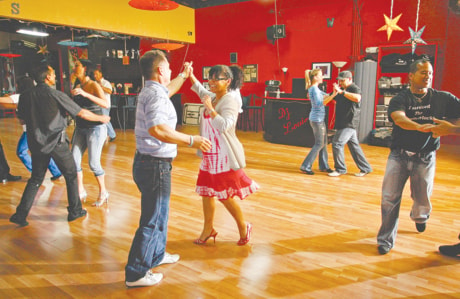TAMPA, Fla. — Cathy Coomes started salsa classes because she thought it might be fun.
A year later, she’s been repeating the syllabus at Simone Salsa Dance School. It did turn out to be fun, and she’s lost 40 pounds (18 kg).
Best of all, salsa made her feel good.
The former mental-health therapist thinks back to her first day at the studio, stumbling awkwardly to a graceful beat, conscious of the floor-to-ceiling mirrors, unsure of her body and the weight of another person in her arms.
That’s a distant memory now after months spent with people of all ages, walks of life and cultures (Coomes is of English and Scottish ancestry) helping each other learn an intricate dance with its roots in African percussion and Latin rhythms.
“The music has a lot of energy,” said Coomes. “I’d never really met a group of people like this who were so passionate about something, so energetic, and having fun.”
Most people who take up an exercise regimen have abandoned it by the one-year mark. Coomes, 55, had that feeling about gyms, walking and cycling. But she has no intention of leaving the dance floor.
Experts say she has discovered the key to sticking with exercise: It has to be fun.
“When we talk to people, they sometimes tell us they don’t find exercise to be enjoyable,” said Jessica Matthews, a spokeswoman for the American Council on Exercise, a California non-profit.
“I think salsa dancing, or dance in any form, reminds them that being active and moving can actually be fun.”
ACE has been raving about dance for years, as TV shows like Dancing With the Stars and So You Think You Can Dance have piqued interest in everything from swing to hip-hop and tango.
All dancing can raise your heart rate, but salsa stands out, says Matthews, because “it really is more of a high-intensity form of dance.”
For a 150-pound (68 kg) person, 30 minutes of salsa dancing burns about 200 calories, comparable to light jogging, according to ACE. (Salsa will not do much to build muscle, but can provide modest toning.)
Matthews went on to list other benefits: Dancing is weight-bearing, so it’s good for the bones. It is a whole-body exercise. And it helps reduce stress and chronic fatigue, and increase self-esteem and confidence. It even can help the brain, because it requires physical skill and mental focus. A study in the New England Journal of Medicine found that dancing was associated with a lower risk of dementia.
All that, and it’s a social event, too. Coomes refers to the dancers she knows as her “salsa family.”
“It really is more than just a form of exercise,” said Matthews. “It really is more of an experience.”
For Axel Cadenas, 47, dancing is “a form of therapy.”
Cadenas, an automobile technician from New Port Richey, Fla., wasn’t thinking of exercise when he came to Simone Salsa. Born in Venezuela, he came to this country at 17, and didn’t have much exposure to Latin rhythms. Still, he was fascinated by the way salsa dancers use their bodies to interpret the sound.
“I saw a style, an elegance, an artistic impression,” he said.
He had walked away from the gym, too. Cadenas says he found it uninspiring to try reaching 140 on his heart-rate monitor while plodding on a treadmill.
He brought the device to salsa class instead.
“Suddenly, I’m keeping my heart rate at 140 while entertaining myself, having fun,” said Cadenas. “The only bad thing is that I realize that it’s already been two hours and I have to go.”
In two months of dancing, Cadenas dropped about 15 pounds (seven kg).
At one point, “I tried to put on my pants and they fell down by themselves,” he said.
Simone Amaral, who owns the dance school and is its primary instructor, tells her students that becoming a good dancer is about finding inner balance.
Dancers call it “collection,” or becoming a “collected dancer.” It means that you are centered and moving from your core. The concept can be found in yoga, martial arts, many sports — and in life.
“If you have balance in dancing, you will find it in life, no question about it,” said Amaral, 45, who has run the school for 11 years.
She tells of students who, while salsa dancing, overcame illness and social phobias, found husbands and wives, discovered new career paths. Many just learn to relax and connect with their bodies, drop inhibitions and have fun in a new way.
“To us, this is our nirvana.”
A rare cancer brought Josie Gonzalez to the dance studio. Gonzalez, who is Mexican, had never taken lessons, but danced salsa for years with her ex-husband, who was Puerto Rican.
In June 2007, she was diagnosed with chronic myelogenous leukemia, or CML, a cancer in the blood and bone marrow.
Her symptoms included extreme fatigue, pain in her bones and difficulty thinking clearly and remembering things. The treatment immobilized her.
“The hardest thing was thinking I could never do it again,” said Gonzalez, 53.
In June 2009, her doctors changed her medication, and Gonzalez, an insurance representative, told her doctors she had a new goal: to go back to salsa and use the dancing as a physical therapy.
The first classes were difficult. She felt stiff and out of breath. But progress was swift.
“Before I knew it, in three months, I had lost 20 pounds (nine kg) that I had gained through inactivity,” she said. “Not only did it help me lose weight, but I didn’t feel depressed anymore.”
And she felt reconnected with Latin culture.
She recently completed 36 weeks of classes and participated in a choreographed performance for an audience of 400 that included her daughter, son, roommate and co-workers.
“It was just a celebration of life,” she said.
